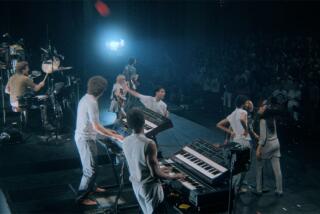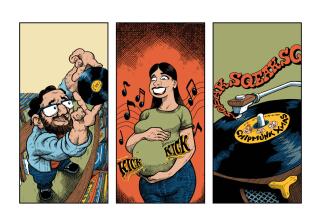Concerts, Cartoons Make Compelling Case for DVD
If you own a big enough TV, have a good stereo system and turn all the lights in your living room off, the DVD experience is pretty similar to watching a movie on the big screen. The image is admittedly better than laser disc’s (with blacks that are really black and colors that seem to pop out of the screen), and the sound as crisp as a CD’s.
These optimum viewing conditions bring the best out of other programs besides feature films, which explains why several companies have already flooded the DVD market with all sorts of documentaries, music specials and short films.
Take the Imax films, for instance. Watching them on VHS would be a lackluster experience. But for those who can’t visit an Imax theater any time soon, DVD is an acceptable alternative. Image Entertainment has just released four Imax films--”Hidden Hawaii,” “Yellowstone,” “Mystery of the Maya” and “Whales”--all of them sumptuous visual treats deserving multiple viewings.
DVD is also proving to be an excellent format for releasing music-related programs. Whereas a concert on VHS could never replace the sound of a CD, investing in a digital video disc of your favorite artist means you also get great quality sound.
Such is the case with two wonderful discs released by Pioneer as part of its Concert Film Series. The first one, culled from the German TV show “MusikLaden,” will delight fans of British glam-rock with rare live performances by seminal ‘70s groups T-Rex and Roxy Music. The other one, deceivingly titled “Celia Cruz: Quantanamera” (they got the spelling wrong on the famous Cuban song “Guantanamera”), is actually a pristine copy of a 1974 show performed in the Congo (when it was still named Zaire) by the legendary salsa group Fania All Stars, which included Cruz. The digitally remastered DVD sounds better than the current CD copies available of the same concert.
Japanese animation is also blossoming on DVD. Manga Video (a division of PolyGram) is taking a stab at the market with the release of 1996’s “Ghost in the Shell,” a visually stunning animated feature that, like most Japanimation, suffers from a plot that is a tad too obscure for the average viewer. You are bound to forget that, however, as soon as you enter the entrancing visual world that director Mamoru Oshii created for this tale of a near future as alienating as it is violent. The DVD (which is certainly not for kids) includes a tedious “Making of” documentary and exhaustive production notes.
*
Ernesto Lechner can be reached at LechnerE@aol.com.


